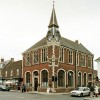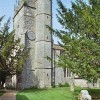In the valley separating Hambledon Hill from the eastern escarpment of the Dorset Central Downs is the village of Shillingstone, situated on the Sturminster to Blandford road. Domesday Book records it in the Hundred of Hunesburg, later it transferred to the Hundred of Cranborne.
At the end of the Saxon period the Manor belonged to Harold as Count of Dorset. Fighting as King Harold II in 1066 he died in battle at Senlac, defeated by William the Bastard of Normandy who is remembered today as William the Conqueror. William granted the manor to one of his supporters, a man named Schelin or Eschellings in whose family it remained for several generations before passing through marriage to the Turbervilles.
In 1303 Sir Brian Turberville granted to Walter de Dyngel, for life, a large acreage of land with some buildings. The arrangement was subject to his celebrating Mass before the altar of the Blessed Mary in Ocford Parish Church, or, if prevented from doing so by infirmity, paying to the poor of the parish ten shillings at the Feast of St. Michael and five shillings at the Annunciation. The Mass was to be said for “the health of his soul, and of Isabel, his wife, Joan formerly his wife, Robert Turberville his father, Sibila his mother, and Viviana and others of his ancestors.” In 1405 Richard Turberville confirmed to John Corston, rector a moiety of the church, the land, woods and meadows, pastures etc, formerly held by William Fithing as rector.
The manor passed from the Turbevilles to the Haseldenes, an Essex family and in 1565 Francis Haseldene sold the manor to Thomas Brooksby. Forty years later in 1603 Bartholomew Brooksby was involved in a conspiracy to overthrow James I and put Arbella Stuart on the Throne. The plot failed and Brooksby saw his lands confiscated; he was then outlawed. For a while before 1592 Arbella Stuart had been considered a candidate to succeed Queen Elizabeth I but the influential Cecil family and others decided James would be a better choice.
Sir Edward Coke, a lawyer, purchased the manor in 1604 and his descendants owned it until 1759, when it was acquired by Julines Beckford of Steepleton Iwerne, who had interests in Jamaica. It descended to Lord Rivers and was later acquired by Viscount Portman.



